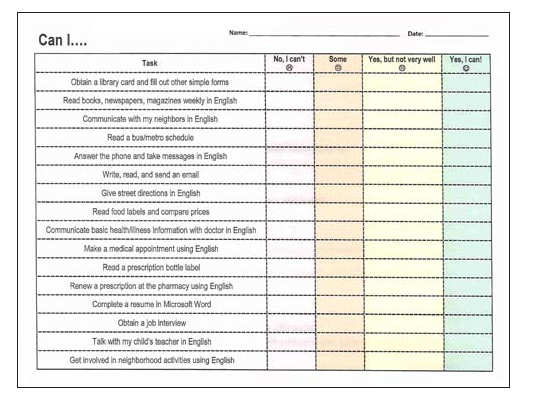-
Program
Administrator
ToolkitA Guide to Implementing and Managing Community-Based Adult ESOL Classes and Programs
-
You are here
Chapter 12: Assessment for Placement
Ensuring Student Success- Chapter 12
Assessment for Placement
♦ NOTES FROM THE FIELD
 A Conversation with Linakages to Learning
A Conversation with Linakages to LearningWe discuss with Debi Edick, Former Coordinator, Family English Literacy Program at Linkages to Learning, changes they made to improve the way they assess students for placement:
To begin with, why did you choose to make the change from what you were doing before?
“When I took over as ESOL coordinator the ‘placement’ test being used was something the previous coordinator had developed. I wanted a placement test that could be used for any level learner and tested learners on what they would be learning once they started ESOL class. We wanted to make the test comprehensive but not overwhelming, especially for lowlevel students or students with limited experience in an educational setting.”
What do you do in the test? What are the skills that you cover, and how do you assess those skills?
“Our primary textbook for the program, Ventures, has a placement test that focuses on reading and grammar recognition. While it’s not perfect, it definitely helps us place learners in the appropriate level of that textbook. Before administering the placement, we conduct a brief interview with potential learners to help determine their speaking and listening skills. Potential learners also fill out a registration form; if we notice they have trouble with this (can only write in a non-Roman alphabet, don’t know how to hold a writing utensil, etc.) we typically forgo the placement test and automatically place them in our basic literacy level. Those learners who display basic reading, writing, speaking, and listening skills are given the placement test. We reiterate that the purpose of the test is to help determine the best class for them and they should not be nervous (although they always are). The placement test is long, 40 questions, so we typically break it up into two parts. If a learner easily gets through the first 10-13 questions we give them the remainder of the placement test, if not, we stop there so the learner does not become frustrated or upset.”
What are the benefits you have seen to these changes?
“Again, the placement test is definitely not perfect. We would like something to measure all four areas of language (reading, writing, speaking, listening) more fully, but the combination of placement test and interviews has definitely helped us to place learners in the appropriate level. We still end up having learners we need to switch to different levels a couple of weeks into the course, but that is happening much less frequently than it used to.”
What are challenges you have had to overcome?
“At sites where we only offer one level, onsite coordinators will sometimes put a learner in a level because that is the only level offered (regardless if the learner actually placed in a lower/higher level). I ask site-staff to refer learners to another Linkages site or contact me, so we can refer the learner to another program where they can be in the correct level. But often the learner wants our location because their child attends that school, so it is a) a very convenient location for them and b) they have a certain comfort level with said location.”



